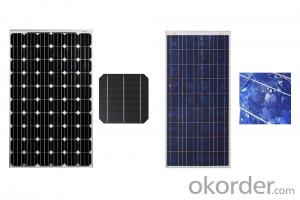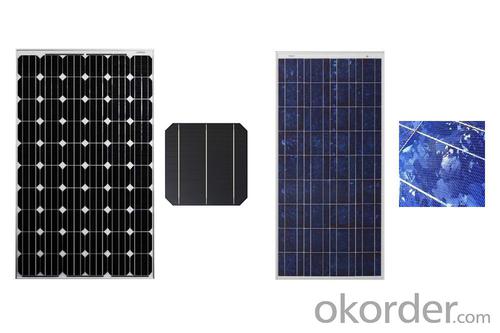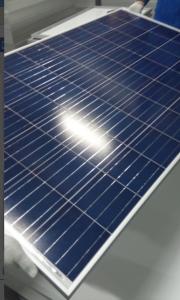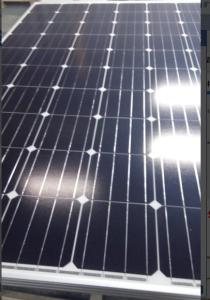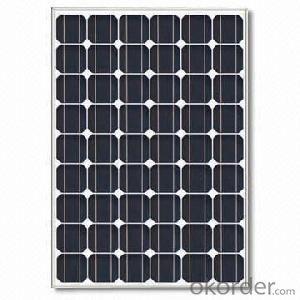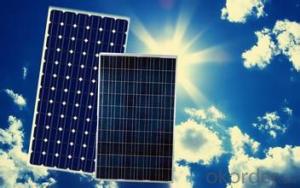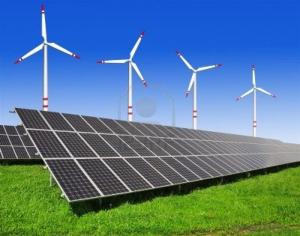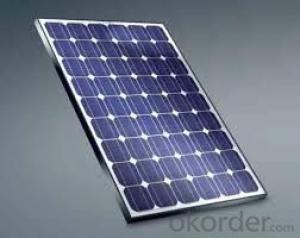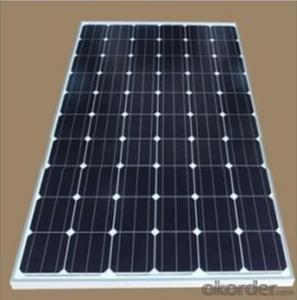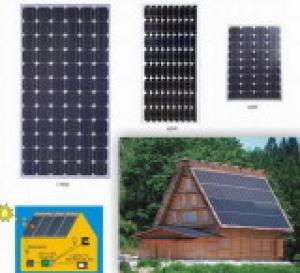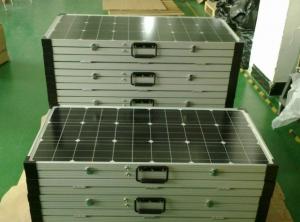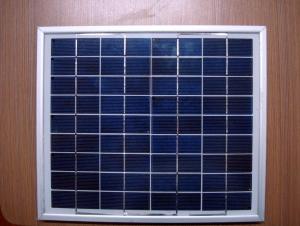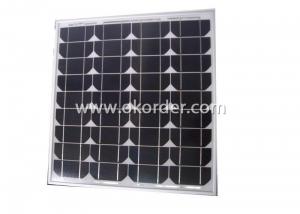40W Mini Monocrystalline Solar Panels on House Roof CNBM
- Loading Port:
- Qingdao
- Payment Terms:
- TT OR LC
- Min Order Qty:
- 10 set
- Supply Capability:
- 300000 set/month
OKorder Service Pledge
OKorder Financial Service
You Might Also Like
Mini Monocrystalline Solar Panel with 40W



Monocrystalline Solar Modules
We offers a range of small, medium and large monocrystalline solar modules, designed for a range of requirements.
Specifications:
Tolerance | +/- 3% |
Cell | Monocrystalline silicon solar cells |
N0. of Cells | 72 (12 x 6) |
Dimension of Modules (mm) | 1581 x 809 x 40 |
Weight (kg) | 15.5 |
Limits:
Operating Temperature | -40~+85? |
Storage Temperature | -40~+85? |
Maximum System Voltage | 1000 VDC max. |
Hail Impact | Diameter of 28mm with impact speed of 86km/h |
Temperature and Coefficients:
NOCT | 48C+/-2? |
Voltage temperature coefficient (%/K) | -0.34 |
Current temperature coefficient (%/K) | 0.09 |
Power temperature coefficient (%/K) | -0.37 |
Characteristics:
Model: | SGM-160D | SGM-165D | SGM-170D |
Max-power voltage Vmp (V) | 34.5 | 35.4 | 35.8 |
Max-power current Imp (A) | 4.64 | 4.66 | 4.75 |
Open-circuit voltage Voc (V) | 41.75 | 43.6 | 43.32 |
Short-Circuit Current Isc (A) | 5.32 | 5.08 | 5.38 |
Max-power Pm(W) | 160 | 165 | 170 |
Model: | SGM-175D | SGM-180D | SGM-185D |
Max-power voltage Vmp (V) | 36.1 | 36.2 | 36.2 |
Max-power current Imp (A) | 4.85 | 4.97 | 5.11 |
Open-circuit voltage Voc (V) | 43.68 | 43.8 | 44.8 |
Short-Circuit Current Isc (A) | 5.49 | 5.48 | 5.51 |
Max-power Pm(W) | 175 | 180 | 185 |
STC: Irradiance 1000W/m2, Module temperature 25?, AM=1.5
Monocrystalline Solar Panels Specifications Range
Maximum Power (Pm) | Dimension | Weight | Operating Voltage (Vmp) | Operating Current (Imp) | Open Circuit Voltage (Voc) | Short Circuit Current (Isc) |
3W | 158x241x25mm | 0.5kg | 8.5V | 0.36A | 10.5V | 0.4A |
4W | 308x166x25mm | 0.77kg | 8.5V | 0.47A | 10.5V | 0.54A |
4W | 308.x166x25mm | 0.77kg | 16.8V | 0.24A | 21V | 0.27A |
5W | 296x215x25mm | 0.3kg | 16.8V | 0.48a | 21V | 0.54A |
10W | 286x406x25mm | 1.5kg | 16.8V | 0.59A | 21V | 0.66A |
12W | 286x406x25mm | 1.5kg | 16.8V | 0.71A | 21V | 0.8A |
14W | 286x541x25mm | 2kg | 16.8V | 0.83A | 21V | 0.96A |
16W | 286x541x25mm | 2kg | 17.2V | 0.93A | 21.5V | 0.99A |
18W | 296x541x25mm | 2.4kg | 18.8V | 1.07A | 21V | 1.2A |
20W | 296x641x25mm | 2.4kg | 17.2V | 1.15A | 21.5V | 1.24A |
24W | 541x451x25mm | 3.15kg | 16.8V | 1.14A | 21V | 1.56A |
26W | 541x451x25mm | 3.15kg | 17.2V | 1.51A | 21.5V | 1.63A |
30W | 296x966x25mm | 3.85kg | 16.8V | 1.78A | 21V | 2.03A |
36W | 541x641x35mm | 4.7kg | 16.8V | 2.14a | 21V | 2.4A |
40W | 541x641x35mm | 4.7kg | 17.2V | 2.33A | 21.5V | 2.5A |
55W | 1057x457x35mm | 6.6kg | 17.6V | 3.12A | 21.6V | 3.3A |
70W | 546x1196x35mm | 8.5kg | 16.8V | 4.15A | 21V | 4.7A |
75W | 546x1196x35mm | 8.5kg | 17.2V | 4.36A | 21.5V | 4.8A |
80W | 546x1196x35mm | 8.5kg | 17.6V | 4.55A | 21.6V | 4.9A |
110W | 1066x811x40mm | 11.8kg | 17.6V | 6.25A | 21.6V | 6.6A |
150W | 1066x811x40mm | 14kg | 34.4V | 4.36A | 43.2V | 4.7A |
- Q: What are the advantages of using solar panels?
- There are several advantages of using solar panels. Firstly, solar panels produce clean and renewable energy, which helps reduce greenhouse gas emissions and combat climate change. Secondly, solar energy is abundant and free, reducing the dependence on fossil fuels and providing a sustainable source of power. Additionally, solar panels can save homeowners and businesses money on their electricity bills by generating their own energy. Finally, solar panels require minimal maintenance and have a long lifespan, making them a cost-effective and reliable energy solution.
- Q: We are thinking about useing solar panels for our house.Does anyone know about solar panels? If so could you please tell me some information on them,and the cost for a home,to install them.
- solar panels are device that convert sun energy into electric energy by physic and chemical effect.solar panels price is high,but you will save your late electricity bill,it is cost effictive.
- Q: Can solar panels be used for powering outdoor lighting?
- Yes, solar panels can be used for powering outdoor lighting. Solar panels capture sunlight and convert it into electricity, which can then be stored in batteries. This stored energy can be used to power outdoor lighting fixtures, making them independent of the grid and environmentally friendly.
- Q: What is the efficiency of solar panels?
- The efficiency of solar panels refers to their ability to convert sunlight into usable electricity. The efficiency can vary depending on the type and quality of the panels, but most modern solar panels have an efficiency of around 15% to 20%. However, advancements in technology have led to the development of highly efficient panels that can achieve efficiencies of up to 40%.
- Q: How to Compare Solar Panels? ?
- The short answer is nobody does. Solar panels just generate electricity and only when the sun is shining. What you can do however is sell the electricity you have generated to your local power company. Computer solar panel for using computer and how much volt support?
- Q: i want to join multiple solar panels into a bank so i only need one length of wire, i am going to use diodes to stop them sending power back into the one before it. is this ok or do i need something else?
- Maybe. It depends on the panels involved, and what their output is. Not all panels are able to be daisy chained.
- Q: I have to show in a project (a model house) how Solar Panels work. In my model I want to show Solar Panels creating electricity to power a T.V but I need to show how the power gets from the Solar Panels to the T.V. A diagram would be really helpful. Please try and make this as simple as possible as I'm only 3, but try and be specific as well!
- Light consists of small packets of energy called photons. When photons with sufficient energy strike the photocell its energy is converted into electrical energy which is stored in the batteries as dc voltage. To run a TV an invertor is used which converts dc to ac. Now you can make a block diagram of it and present it TC
- Q: Can solar panels be installed on research facilities or laboratories?
- Yes, solar panels can be installed on research facilities or laboratories. In fact, many research facilities and laboratories have started to adopt solar energy to reduce their carbon footprint and dependence on traditional energy sources. Solar panels can be installed on rooftops or open spaces adjacent to the facility, providing clean and sustainable energy to power various equipment and operations. Additionally, the installation of solar panels on research facilities can serve as a demonstration of renewable energy technologies and encourage further adoption within the scientific community.
- Q: What is a good sight that I could go to about installing solar panels and all of the considerations of it?
- Biggest problem is availability of sunshine in the UK. Do you get enough to warrant the fuss or financial layout? Another problem is the orientation of your roof. Facing directly south, with a slope (in degrees) equal to your longitude would be ideal. As far as electricity goes, you have to be tied into the grid to take care of the times you are not generating all the power you need. When you are generating more than you need, you sell it but get paid at the rate the utility normally pays, a lot less than you would pay to buy from them. Still, it's something.
- Q: Can anyone give me some info on how to figure how many panels needed for a 0 volt 2 amp pool motor. Thanks/ Run 5 hours a day
- I don't think heating a 70,000 gallon pool with solar panels is practical. My husband has designed and built our solar hot water system. It works quite well. We live in Arizona. There's no way we could heat that much water using sun energy. You have to heat the water and compete with the outside air.
Send your message to us
40W Mini Monocrystalline Solar Panels on House Roof CNBM
- Loading Port:
- Qingdao
- Payment Terms:
- TT OR LC
- Min Order Qty:
- 10 set
- Supply Capability:
- 300000 set/month
OKorder Service Pledge
OKorder Financial Service
Similar products
Hot products
Hot Searches
Related keywords
